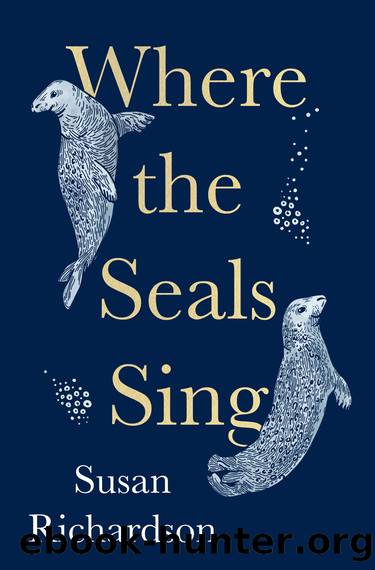Where the Seals Sing by Susan Richardson

Author:Susan Richardson [Richardson, Susan]
Language: eng
Format: epub
Publisher: HarperCollins Publishers
Published: 2022-05-26T12:00:00+00:00
This question is very much at the forefront of my mind as I leave the clangour and clamour of the gannets at Troup Head and retrace my steps to Crovie. As well as a bottling bull seal, snout raised skywards, I at last get a distant glimpse of a small pod of bottlenose dolphins, their fins and flanks emerging and submerging like a needle sewing a running stitch. Yet, wildlife aside, what Iâm finding most striking about todayâs views is the fact that they contain none of the huge floating circular or square structures, beneath which underwater nets hang, that I grew so used to seeing on my way up the west coast to North Uist and around the isles of Orkney. These pens contain farmed salmon â though there may not be any here on the east coast, more than two hundred aquaculture sites operate elsewhere in Scotland, making it the third-largest producer of farmed salmon in the world. And while thereâs no longer a seal-shooting issue at wild salmon nets as a result of that fishing practice having been banned, killings still occur around fish farms.
Many other animal welfare and environmental concerns, in addition to seal shootings, have been voiced in respect of intensive salmon farms in recent years. These include overcrowding â each pen holds many thousands of fish with a percentage struggling to feed and starving to death; infestations by parasitical sea lice, in part due to the congested conditions, that can eat the salmon alive; the use of toxic chemicals, with implications for the wider marine environment, to attempt to control the sea lice; unsustainable harvesting of wild wrasse that get dumped into the pens to act as âcleanersâ as an alternative means of parasite elimination; and the use of thermolicers, heated water chambers, into which the salmon are sucked, which have at times resulted in accidental mass mortality events rather than successful de-licing.
That seals are attracted to pens containing thousands of live, and a proportion of dead, fish is no surprise, nor is the salmon industryâs claim that seal attacks cause serious losses of both fish and equipment. It insists, too, that seals are only shot under licence by skilled marksmen as a last resort but I remain perplexed by this argument, the legitimisation of killing that the licence scheme seems to offer and the fact that thereâs no external monitoring of the number of shootings or an assessment as to whether quotas are being adhered to or exceeded. Eager to discuss these issues, Iâve made contact with the Seal Protection Action Group, whose long-standing Saving Scotlandâs Seals campaign contributed, in part, to the Scottish governmentâs decision to introduce the licensing scheme on the basis that it would outlaw unregulated shooting.
In a phone call that stretches much longer than expected, like the foraging journeys of weaned pups, the director of the Seal Protection Action Group, Andy Ottaway, explains that it grew out of a small organisation which was formed in Orkney in opposition to the 1970s cull.
Download
This site does not store any files on its server. We only index and link to content provided by other sites. Please contact the content providers to delete copyright contents if any and email us, we'll remove relevant links or contents immediately.
The Lonely City by Olivia Laing(4151)
Animal Frequency by Melissa Alvarez(3778)
All Creatures Great and Small by James Herriot(3550)
Walking by Henry David Thoreau(3258)
Exit West by Mohsin Hamid(3222)
Origin Story: A Big History of Everything by David Christian(3167)
COSMOS by Carl Sagan(2977)
How to Read Water: Clues and Patterns from Puddles to the Sea (Natural Navigation) by Tristan Gooley(2903)
Hedgerow by John Wright(2797)
The Inner Life of Animals by Peter Wohlleben(2790)
Origin Story by David Christian(2712)
How to Read Nature by Tristan Gooley(2686)
Project Animal Farm: An Accidental Journey into the Secret World of Farming and the Truth About Our Food by Sonia Faruqi(2682)
How to Do Nothing by Jenny Odell(2667)
Water by Ian Miller(2616)
A Forest Journey by John Perlin(2607)
The Plant Messiah by Carlos Magdalena(2475)
A Wilder Time by William E. Glassley(2380)
Forests: A Very Short Introduction by Jaboury Ghazoul(2354)
